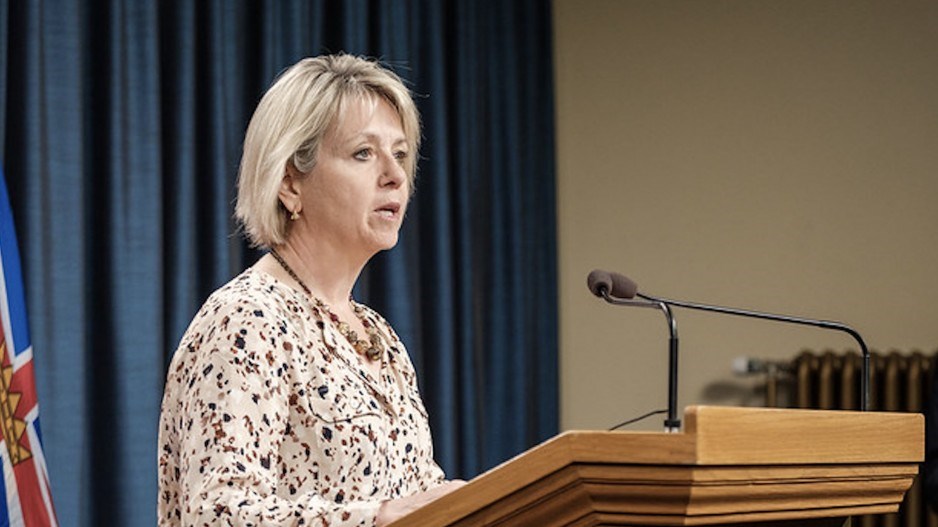The strict health orders issued in B.C. in November appear to have successfully bent the COVID-19 curve in the province, B.C. Health Officer Bonnie Henry said Wednesday.
Numbers continue to rise, however. For the last 24 hours, B.C. recorded 518 new cases of COVID-19, with more than half again coming from the Fraser Health region (332). Meanwhile, Vancouver Coastal Health saw 97 new cases, with nine more in Island Health, 49 in Interior Health and 31 in Northern Health.
There are currently 9,137 active cases in the province, with 348 patients in hospital while 80 people are in the ICU receiving treatment. Another 9,689 are under active health monitoring (although that number currently does not include Northern Health figures due to ongoing data migration).
Henry also said there have been another 19 deaths, bringing the death count up to 796.
According to what Henry presented on the province’s COVID trajectory for December, the infection contact rate index has now fallen below 1 – meaning each infected person is in turn infecting one person or fewer.
That number, Henry said, is the difference between the COVID curve skyrocketing versus plateauing and falling over the next month.
“That’s where we are now, which means what we are doing is working,” Henry said of the stricter restrictions introduced in November. “But we cannot let up... It doesn’t mean we are out of the woods.
“We have bent our curve slightly. But we need to be cautious, because it would not take much to get us back into the danger zone.”
According to the data released Wednesday, both the daily new cases number and the 7-day moving average of new cases peaked in mid-November, with the vast majority of the COVID cases this year being linked to known local cases and clusters.
The recent spike saw the biggest increase in the 20-29 age group in terms of new COVID cases, Henry said, while the two sets of new restrictions (introduced in the week of Nov. 4 and Nov. 18) has lead to a drop in new cases across all regions and demographics after two weeks – the maximum incubation period of the COVID virus inside an infected person before symptoms manifest.
Henry said the province has paid specific attention to the impact of the virus on schools and its population of students. The December trajectory showed that – of the 120,000 children and staff in the Vancouver Coastal Health Region – only about 600 have tested positive for the virus, leading to only 200 cases of exposures and zero outbreaks.
Most of the cases of transmission have happened between adult staff members at the school, Henry added.
“The data shows us that we are not seeing schools as a place where transmission takes place widely,” she said. “That tells us that when the safety protocols that are place in schools are followed, it is a very safe environment - and transmission is very unlikely.”
Henry also issued a new provincial health order, calling for a phased re-start of work camps on projects in Northern B.C. in January as workers return from the holidays. The details of how the phased startup will work have not yet been released.
“[The nature of camp startup] means there are workers travelling to and from camp,” Henry said. “January sees an influx of people from not only within the province but also from outside B.C. Right now, we know Northern Health is stretched. We are already seeing small communities under strain, and the new order ensures we can maintain services in those communities.”
Wednesday also saw two additional outbreaks at long-term care facilities: White Rock’s Evergreen Baptist Health Centre and Richmond’s Minoru Residences. That, along with two outbreaks declared over, kept the number of active outbreaks in the province at 55, with 1,414 residents affected to date.
With the holiday season taking place, Henry again reminded retailers to enforce safety rules and keep the consumers safe, while also telling the general public to continue to exercise caution in wearing masks, washing hands and practicing social distancing while limiting in-person contact to the smallest possible number.
“As we know, the modelling has shown the actions we are taking are working,” Henry said. “I know the orders and the restrictions are difficult. But we also know we have learned... when we don’t have gatherings, when we wash our hands, when we wear our masks, when we stay home when we are ill, when we work from home as much as possible and we make sure to follow our COVID safety plans in all settings, we can reduce and stop the transmission of this virus.”




